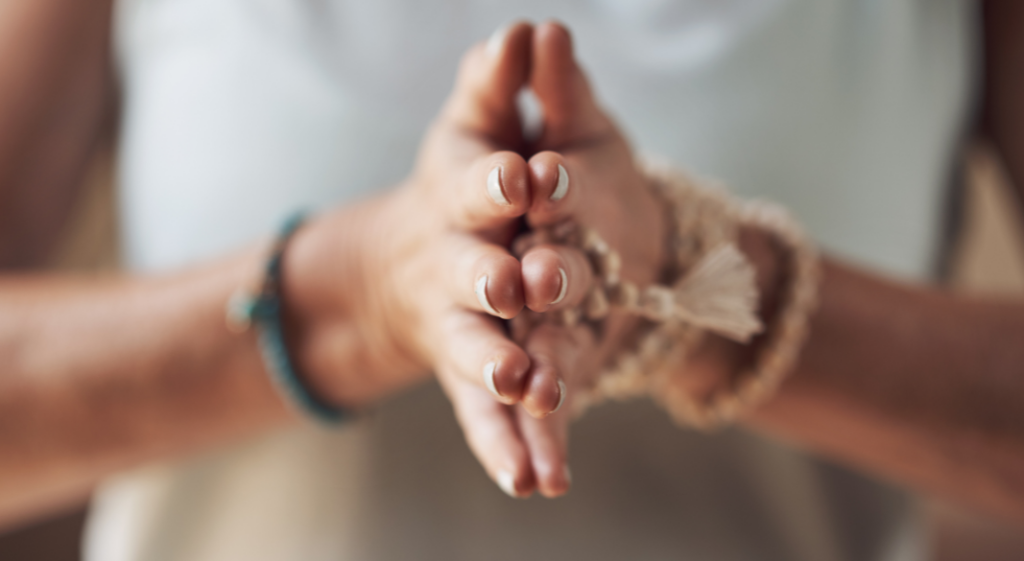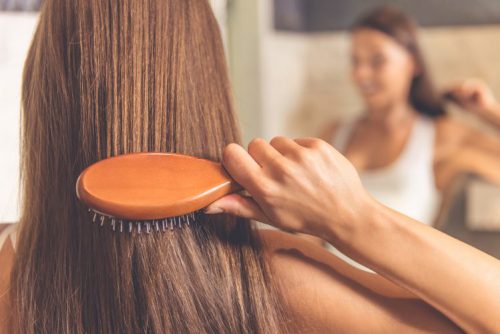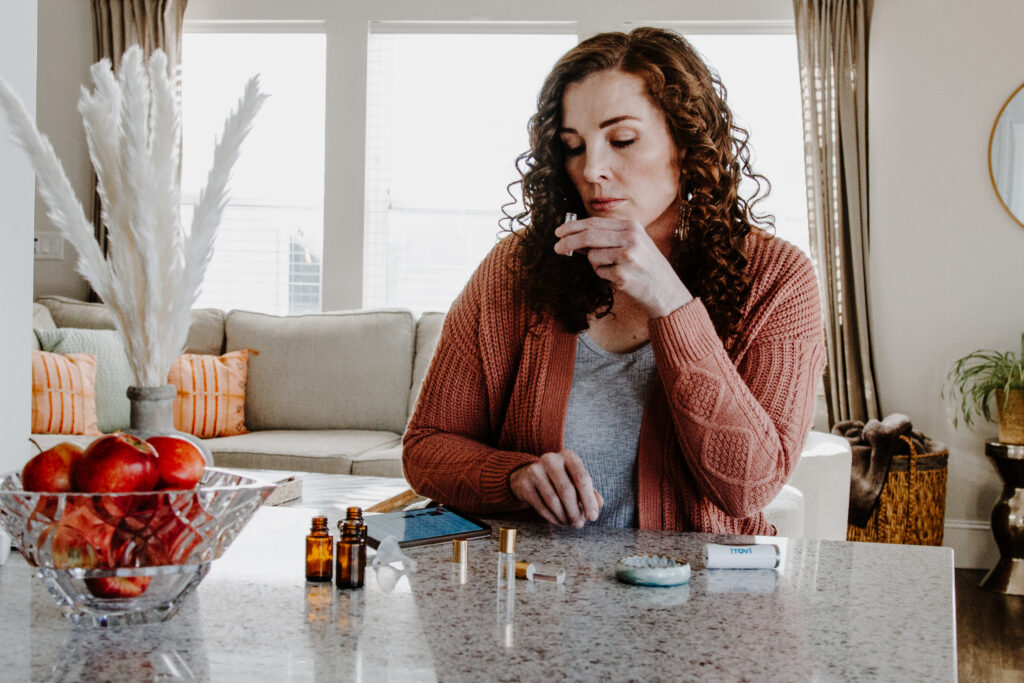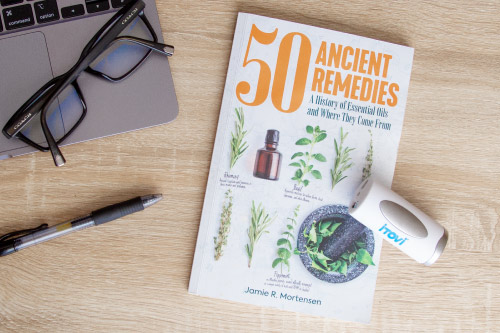Just how much does hair care matter to wellness? And is it really worth it to make dedicated hair care a part of your wellness routine?
As it turns out—yes!
Physically, your hair protects your head and brain from sun damage and its health serves as an important sign of your overall health. And emotionally, our hair plays significantly into our daily confidence, self-esteem, and self-expression!
(Seriously, one study found that 81% of women feel that a good hair day boosts their confidence!)
A solid hair care routine can have a big impact on our wellness! But where does one begin? We start with learning “The 3 Major Steps to Taking Care of Your Hair” and then learn “How to Use Essential Oils in Shampoos & Other Hair Care Solutions”.
The 3 Major Steps to Taking Care of Your Hair
Step #1: Take Care of Your Scalp
Healthy hair begins with a healthy scalp, because your scalp, the patch of skin at the top of your head, is what holds, protects, and otherwise maintains your 100,000 hair follicles!
When this scalp skin is kept clean, free from irritation, and supported with proper nutrients and circulation, your hair follicles can stay safe and can produce strong, healthy, hair! But taking care of your scalp can be harder than it sounds because your own hair often traps dirt, bacteria, and other nasties on your scalp!
If these pollutants aren’t cleared out they can clog up the works, prevent hair growth, cause itching, and bring on dandruff and scalp infections like psoriasis—which is why regular washing is so important!
How do I take care of my scalp?
-
- Focus on your scalp when you apply shampoo. This is the area that needs the most cleansing. Massage your shampoo into the roots of your hair all around your head and rinse well! Do not waste shampoo by lathering it into the shaft portions of your hair. That’s what the conditioner is for.
- Use natural, high-quality shampoo on your scalp. The wrong shampoos can irritate your scalp and won’t clean out the bacteria as well. (Learn about EO shampoos here.)
- Consider using a scalp toner, exfoliant, and/or a hair mask every once in a while.
- Watch your diet. When your body hands out nutrients to the various systems, organs, and structures in your body, the hair is often the last to get any. So make sure your diet is full of good nutrition and don’t fill it with too many dairy products, fats, sugars, and salt.
Step #2: Treat Your Hair Gently
Your hair can only take so much stress and, unfortunately, there are many, many things that can damage it, like excess heat, strain, and chemical interference—which is why there are some definite do’s and don’ts when it comes to your hair!
Here are a few ways to treat your hair gently:
- Use lukewarm or cool water when washing your hair. Too much hot water can ultimately damage and dry out your hair.
- Dry your hair correctly. Air drying is the gentlest method. And, if you’re in more of a hurry, microfiber cloth or a t-shirt will be gentler on your hair than a rough towel. You can still blow-dry it for special occasions, of course, but try not to do it every day. Also, when possible, try to style it without the use of heating instruments.
- Comb your hair instead of brushing it, especially when wet. Wet hair is more vulnerable to breakage. So, firstly, try to comb out your hair before getting in the shower. And secondly, when you must comb out wet hair, be gentle, starting at the ends and working your way up with a wide-toothed comb. Use a detangling spray if it helps.
- Do not sleep with wet hair. This can encourage bacterial growth in your hair, on your pillow, and increase breakage as well.
Step #3: Protect Your Hair
The more you can strengthen, protect, and defend your hair from environmental threats and other damages, the more healthy and beautiful your hair will be!
- Condition Correctly. Conditioner is best applied to the bottom portion of your hair, not the roots (that’s where the shampoo should be focused). And unless you are specifically using a leave-in conditioner, be sure to rinse thoroughly.
- Trim Your Hair Regularly. Frayed, dry, split, unhealthy hair often begins at the hair ends. Protect your hair in the long term with regular trimming, even if you are trying to gradually grow out your hair.
- Cover it! Hats can help protect your hair from damage from excess sun. And caps are a great idea for swimmers who want to protect their hair from chlorine damage.
How to Use Essential Oils in Shampoos & Other Hair Care Solutions
The Ground Rules
The first thing to know is that no hair care solution should include any concentration of essential oils higher than 2%! In fact, most recipes have concentrations lower than 1%.
Also, before using any oils, be sure you do a patch test!
Essential Oils & Commercial Shampoos
For the health of your skin, it’s best to avoid shampoos with too many chemicals or any parabens, sulfates, or synthetic fragrances—which is why many encourage staying away from commercial shampoos.
If, however, you’ve found a store brand that you like that you want to combine with your own essential oils, remember—do not pre-mix them, that is, do not add your essential oils to the bottle and just let it sit there. Over time, your essential oils can cause the ingredients of your store-bought shampoo to separate, weakening the shampoo as a whole.
If you want to add essential oils to a store-bought shampoo, squirt about a tablespoon’s worth of shampoo into your hand, add 2-3 drops of your chosen essential oil (or 1 drop per teaspoon’s worth of shampoo product), mix the shampoo and oil thoroughly together with your finger, and immediately apply.
Afterwards, make sure that all the shampoo is thoroughly rinsed out of your hair.
Essential Oils & Homemade Shampoos
To avoid chemicals, sulfates, and other unhealthy ingredients, you can make own homemade shampoo!
Most homemade, natural shampoos have a base (85%+ of the solution) made up of ingredients like unscented castile soap, coconut milk, distilled water, and sometimes honey. And popular minor ingredients include essential oils, carrier oils like jojoba or almond, vitamin E oil, and aloe vera.
Note, however, that some people have reported that their hair takes a while to adjust to and actually benefit from using such shampoos. So if you’re going homemade, be sure to monitor your hair’s reaction carefully!
Which Essential Oils Can I Use in My Hair Care?
Many essential oils carry antioxidant, antibacterial, anti-inflammatory, and other properties that make them useful for hair care. Not that you should just choose any topically-safe oil and use it in your hair care. You should consider your hair’s specific needs and choose an oil from there.
To get you started, here’s a handy list:
For dry hair in need of moisturizing: Frankincense, Geranium, Jasmine, Roman Chamomile, Sage, & Ylang ylang
For oily hair: Citronella, Yarrow, Clary Sage, Geranium, Lemon, & Sage
To encourage hair growth: Blue Tansy, Fennel, Frankincense, Lavender, Manuka, Melissa, Sandalwood, Siberian Fir, Bergamot, Cedarwood, Clary Sage, Dill, Eucalyptus, Geranium, & Sage
For dandruff: Citronella, Frankincense, Helichrysum, Manuka, Tea Tree, Cedarwood, Clary Sage, Eucalyptus, Lime, & Patchouli
For scalp health: Blue Tansy, Citronella, Lavender, Tea Tree, Sandalwood, Siberian Fir, Bergamot, Jasmine, Lemon, Lemon Myrtle, Patchouli, Roman Chamomile, Rose, Sage & Thyme
Final Word
While some may think it’s all about vanity, hair care is an important part of everyday wellness and fully deserves the support of essential oils!
Put habits in place that will allow you to keep your hair healthy and presentable so that you can enjoy the full physical and emotional wellness benefits of healthy hair!




